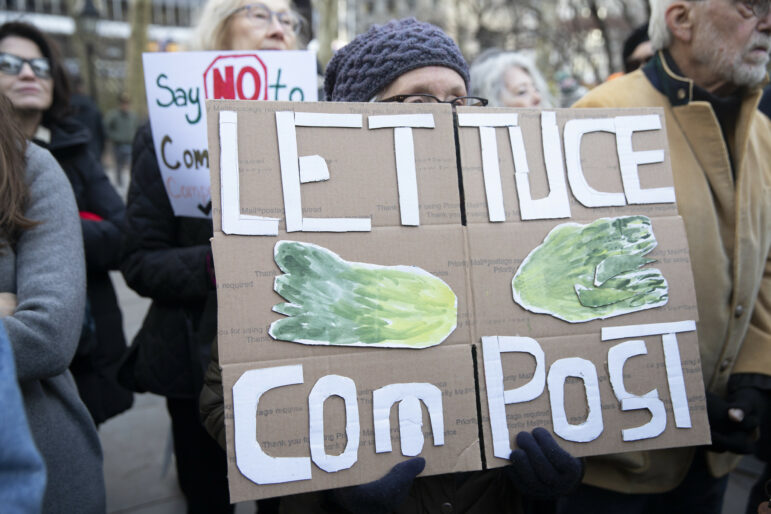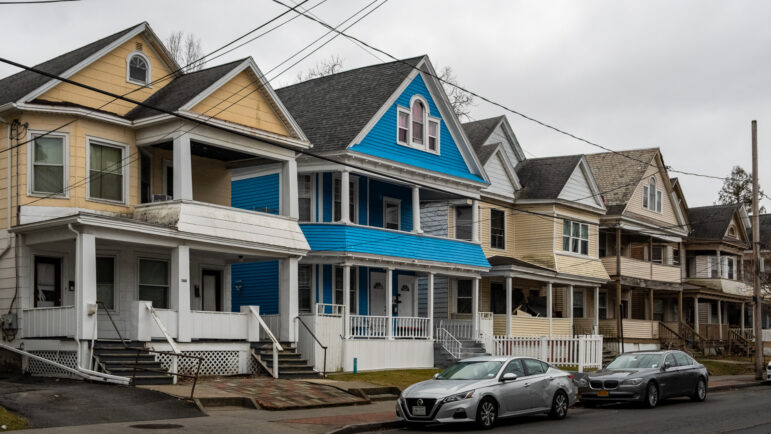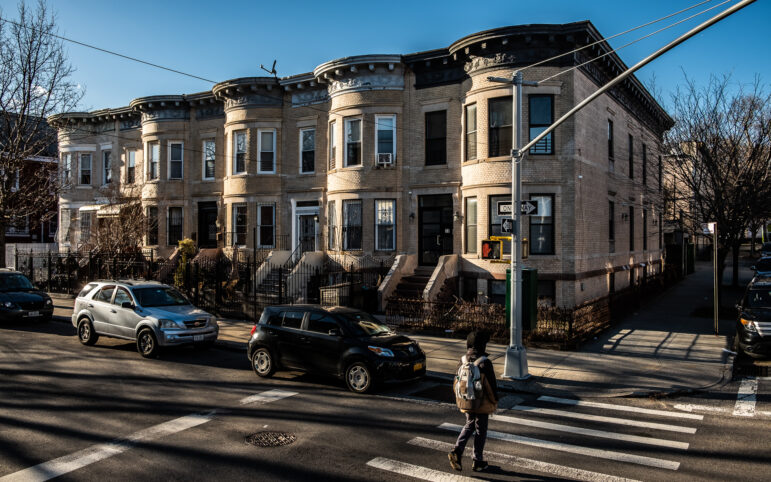Most of the food scraps and yard waste collected by the city isn’t getting composted. Instead, it’s being turned into fuel to heat people’s homes—and that’s not actually great for the environment, climate advocates say.

Adi Talwar
Green waste being dumped from a 64 gallon toter.New Yorkers might be surprised to learn that only 20 percent of the food scraps and yard waste that the city collects from the curb is actually turned into compost, according to the Department of Sanitation (DSNY).
But a bill introduced this spring, and the subject of a City Council hearing on Monday, would change that by requiring DSNY to establish at least one organic waste composting facility in each borough between 2026 and 2027.
“The goal is to generate more compost for local use,” Councilmember Sandy Nurse, the bill’s sponsor, told City Limits. “Compost is an important input for our local ecosystem. And producing that locally and using it locally is beneficial to the environment.”
More than a third of the city’s waste—36 percent—is suitable for composting, which turns food scraps and yard waste into a dark, nutrient-rich soil that can be used to fertilize plants.
That’s good for the environment, since organic waste that’s thrown into a landfill gets suffocated by trash and as it decomposes, releases greenhouse gas emissions that drive climate change. Mayor Eric Adams says he is committed to diverting all organic garbage away from landfills by 2030, and sorting of this waste will become mandatory citywide this fall.
But right now, 80 percent of the food scraps and yard waste collected is being fed to wastewater treatment plants, where the organic material is broken down through a process called anaerobic digestion. A biogas, primarily methane, is extracted from the digested material and turned into energy to heat businesses and homes.
While converting organic waste into energy is a better alternative to throwing it in a landfill, environmentalists say it’s not without pitfalls.
The scarps-to-fuel approach emits its own share of greenhouse gasses, and the process has the potential to leak methane into the atmosphere. Methane has more than 80 times the warming power of carbon dioxide over the first 20 years after it reaches the atmosphere.
Another issue is that once the methane has been extracted, a leftover sludge known as “digestate” often ends up getting thrown into the landfill anyway.
“The digestate is being landfilled because the organic waste is mixed with sewage waste during the process, and it becomes so contaminated that it loses the quality it needs to turn into finished compost that can be applied to agriculture,” said Eric Goldstein, New York City environment director at the Natural Resources Defense Council (NRDC).
“From an environmental and sustainability standpoint, the best approach is to compost that organic waste and return it to soil where it can serve as a soil enhancer,” he explained.

Adi Talwar
February 16, 2023: Compost bagging machine at DSNY’s 33 acre composting facility in the Fresh Kills section of Staten Island.Goldstein calls Nurse’s bill to boost the city’s composting capacity “the most important piece of solid waste legislation that the City Council will be considering this year.”
New York City is currently home to two facilities that can process food waste for both composting and anaerobic digestion; one is located on Staten Island and the other in Brooklyn. DSNY does note, however, that it is looking to diversify where the city’s organic material goes, and have an active procurement for vendors that has the potential to change the number of facilities churning out compost.
Nurse told City Limits that the goal of her bill is to encourage the build out of sites solely dedicated to composting—smaller alternatives to the high-tech and expensive facilities currently processing both aerobic digestion and compost.
But the Department of Sanitation begs to differ. It will still cost billions of dollars to build these facilities, which will take up a lot of space, the agency said at a Council hearing on Monday.
“At 33 acres, the Staten Island Compost Facility is slightly larger than Ellis Island. The requirements of this bill would require about three times as much space as that – so more than three Ellis Islands, 90 acres, in each borough,” DSNY Commissioner Jessica Tisch said at the hearing.*
DSNY also took issue with the proposed timeline, saying it doesn’t give the city enough time for the massive undertaking, and with the fact that the bill excludes aerobic digestion, which officials argued is a better option than throwing organic materials away.
“We need to accept that the goal is getting this waste out of landfills,” Tisch said. “New York City already produces more compost than we can give away, and reducing our need for fracked gas by producing renewable energy from food waste is also a noble goal and a substantial win for the environment.”
Still, environmental advocates say they will be backing the bill, especially since the Adams administration has defunded the city’s community composting program—neighborhood sites where residents could drop off food scraps. The move has caused national uproar among the environmental community, since it was considered among the most successful community-run composting programs in the nation.

John McCarten/NYC Council Media Unit
Advocates at a rally to save the city’s compost program from budget cuts in December.“Compost is a valuable resource that can be used to nourish the depleted soil of local parks, community gardens and street trees and the over 12,000 rain gardens the city has created as part of its climate resiliency plan,” said Jane Selden, chair of the committee on waste reduction at the environmental group 350 NYC.
These rain gardens, Selden explained, are important for flood mitigation because they act as a sponge, soaking up to six times their weight in water when it rains, keeping it away from the city’s streets (and after, its sewers and waterways).
“Local composting plays a vital role in moving our city closer to achieving its greenhouse gas reduction and infrastructure resiliency goals,” she underscored.
*This story was updated since initial publication to include additional information from the Sanitation Department.
To reach the reporter behind this story, contact Mariana@citylimits.org. To reach the editor, contact Jeanmarie@citylimits.org.
Want to republish this story? Find City Limits’ reprint policy here.








